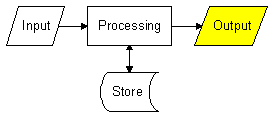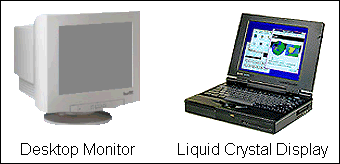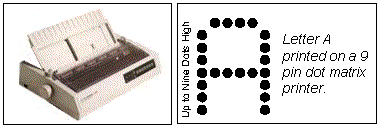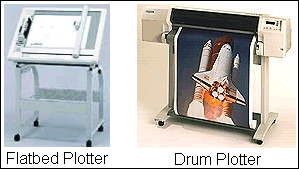
Output Devices |
Once an information system has processed the inputs it receives it must present the results of the processing for the user.

An output device takes data from the computer and converts this into information in a form which is normally understandable by humans.
There are many different output devices available. Each output device is suitable for a different purpose. Select an output device from the table below to find out about it or read through the rest of this topic to learn more about all of the different output devices.
| Soft Copy Output Devices | ||
| Monitors / VDUs | ||
| Hard Copy Output Devices | ||
| Printers | Dot Matrix | |
| Laser | ||
| Ink Jet | ||
| Thermal | ||
| Plotters | Flatbed | |
| Drum | ||
| Other Output Devices | ||
| Sound | Speakers | |
| MIDI | ||
| Microfilm (COM) | ||
| Control Devices | ||
Almost all computers have a monitor. Monitors are also known as Visual Display Units (VDUs). Most computers use this display as the main output device. There are two different types of display :

The two most important features of a screen are its size and its resolution. There is more information about these features below. They apply to both desktop monitors and LCDs.
Size : How big is the screen ? Typical sizes are 15", 17" or 21". The size is measured along the diagonal from the bottom left hand corner to the top right hand corner of the screen.
Resolution : An image displayed on the screen is made up of lots of tiny dots called pixels. If you look closely at the screen you may be able to see these pixels. The resolution of the screen is how many pixels there are up and down and from left to right across the screen. A variety of different resolutions are available. For PCs these resolutions have names. e.g. VGA is 640 x 480. This means that there are 640 pixels in each row across the screen and 480 pixels in each column up and down the screen.

The most common current resolutions are XGA (1024 x 768) and SXGA (1280 x 1024). Displays with lots of pixels are called high resolution. Displays with fewer pixels are called low resolution. High resolution displays can show much more detail than low resolution ones and are required for applications such as Computer Aided Design (CAD) and Multimedia. Here are close-up pictures of a circle, one shown on a high resolution display and one on a low resolution display :

Images displayed on the screen are temporary, i.e. they do not last forever. For this reason they are called soft copy.
People often prefer to get printouts of the work they have done rather than to look at it on a monitor. Printouts are called hard copy. Unlike images on a screen hard copy can provide a permanent record of work and can be looked at away from the computer. Hard copy can be obtained using a printer or a plotter. There are lots of different types of printers and plotters available. They vary in the method they use to produce hard copy and the cost and the quality of the hard copy they produce. Different devices are suitable for different applications.
The main types of plotters and printers are listed here :
| Printers | Dot Matrix | |
| Laser | ||
| Ink Jet | ||
| Thermal | ||
| Plotters | Flatbed | |
| Drum |
A dot matrix printer is known as an impact printer because it makes an image on the page by hitting a hammer against a ribbon. Printers which do not do this are known as non-impact printers.
Dot matrix printers are impact printers. They produce an image by hammering a column of 9 or 24 pins against a ribbon. Characters are produced as the print head (which contains the pins) moves across the page.

Dot matrix printers are cheap to purchase and have low operating costs. Most can run in either draft mode (quick but very low quality) or Near Letter Quality mode (slower but better quality). If carbon paper is put into the printer then a dot matrix printer can print more than one copy of a document at a time. This feature is often used by companies when they print invoices, bills etc. The company can keep one copy themselves and send the other copy to the customer. Dot matrix printers typically print at speeds around 300 characters per second (cps).
The disadvantages of dot matrix printers are that the output quality is poor, it takes a long time to print a document and the noise can be annoying.
Laser printers are called page printers because they print a whole page at a time. A laser beam is used to draw the image to be printed onto a light sensitive drum. After the image has been drawn on the drum a fine powder ink called toner is put onto it. The toner only sticks where the laser has drawn the image. The paper then passes over the drum and the toner is transferred onto the paper.

Laser printers produce very high quality output, are very quiet and very fast. Typical home laser printers can print 16 pages per minute (ppm). Some industrial versions print over 100ppm and can print on both sides of a piece of paper at the same time. The main disadvantage of this type of printer is the high purchase cost. Small laser printers cost from £80 to buy and are more usually about £600. Colour laser printers cost £500+. Running costs are higher than dot matrix printers but lower than most ink jet printers.
Ink jet printers are the most popular type of printer for use at home or in a small business. This is because they are relatively cheap to purchase and can print in colour. Ink jet printers generate output by squirting tiny jets of ink at the paper to be printed on. A column of ink jets in the print head moves across the page squirting dots onto the paper to make the image.

Typically ink jet printers can produce 1200 to 4800 dots per inch (dpi). Because these dots are made with liquid ink photographs usually look better when printed on an ink jet printer than on a laser printer printer, but the quality of printed text is not quite as good. Ink jet printers nearly always print in colour and cost from £30 upwards. They are slower than laser printers (8 pages per minute+) and cost more to run as the ink cartridges they use are expensive.
Thermal printers are no longer used as printers for microcomputers. They are however still used in some computer control systems, tills and in many fax machines. These printers print on special heat sensitive paper which is relatively expensive. The image is produced from small black dots which are made on the paper by heating it up. The quality is reasonable and graphics can be printed. Documents printed on a thermal printer usually fade over time.
A plotter can be used to produce very large drawings on paper sizes up to A0 (16 times as big as A4). A plotter draws onto the paper using very fine pens. There are two types of plotter. They differ in the way that the pen can be moved about on the piece of paper to draw lines :
Flatbed Plotter : The paper is fixed and the pen moves left and right and up and down across the paper to draw lines.
Drum Plotter : The pen moves up and down on the paper and the paper is moved left and right by rotating a drum on which the paper is placed.

Plotters can automatically change their pens and so can produce colour output. The lines drawn by a plotter are continuous and very accurate. Plotters are very slow but produce high quality output. They are usually used for Computer Aided Design (CAD) and Computer Aided Manufacturing (CAM) applications such as printing out plans for houses or car parts. The quality of the output produced by ink jet printers is now very good and large format (big) ink jet printers are steadily replacing plotters for most tasks.
Sound can be output through loudspeakers or headphones. On microcomputers you also need to install a sound card to be able to output sound. If you want you can connect the computer to a hi-fi to get louder, better quality sound than you would if you plugged the loudspeakers straight into the computer. The sound produced by microcomputers is now better quality than sound that is recorded on a CD.
Sometimes a computer can read out text that has been entered into it by using a computerised or recorded voice. This type of system is known as speech synthesis.
The Musical Instrument Digital Interface (MIDI) system allows a musical instrument to communicate with a computer system. The musical instrument can act as an output or input device. As it is played computer software records information about the duration, pitch and volume of each note.
Music input into a computer by a MIDI instrument can be saved or edited by the user. It can also be printed out as a musical score. The computer can play the recorded piece of music either through its own speakers or through a MIDI instrument that is being used as an output device.
Sophisticated MIDI software can receive inputs from up to sixteen musical instruments at once and can play music back on many instruments simultaneously. The various instruments can all be sequenced together so that they play back in time with each other.
Microfilm is a special type of photographic film which can store images at greatly reduced sizes (about 1/50th of the original size). Traditionally companies that needed to store a lot of documents would photograph the documents and store the images on microfilm. The original documents would then be destroyed and the microfilm photographs of the documents would be kept instead. The microfilm photographs were much smaller than the original documents so they could be stored more efficently and cheaply.
Images stored on microfilm can be viewed using a special reader that magnifies the images and projects them onto a screen. Suitable readers are fairly cheap to buy.
Computers can output information directly to microfilm for long-term storage. This is known as Computer Output on Microfilm (COM).
Microfilm is rarely used today. Documents which need to be stored are usually scanned and saved electronically on high capacity storage media. Documents stored electronically can be indexed and searched more efficiently than documents stored photographically on microfilm.
Computers can also be used to control other devices such as motors and lights which can be switched on and off. These devices are activated by electrical signals sent to them by a computer.
There are lots of different devices available. Examples of common devices include :
| Device | Action Produced | Application |
| Bulb | Lights up an area. | Lighting up a garden when a person walks into the area. |
| Motor | Rotation of a shaft. | Moving a buggy. |
| Buzzer | Makes a short beep noise. | Warning a pilot of a dangerous situation. |
| Pump | Moves gasses or liquids from one place to another. | Keeping a fish tank supplied with oxygen. |
| Heater | Produces heat. | Keeping a house warm in a central heating system. |
| LCD Display | Displays short sequences of numbers or letters. | Information readout on a till. |
The action of many devices will depend upon how high or low the analogue voltage that is sent to the device is. For example :
Devices like these are used by computerised control systems.
Computer Assisted Manufacturing (CAM) systems can control devices such as CNC lathes and robots and use these to make items.
GCSE ICT Companion 04 - (C) P Meakin 2004